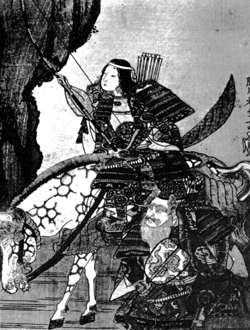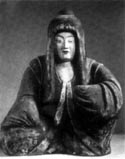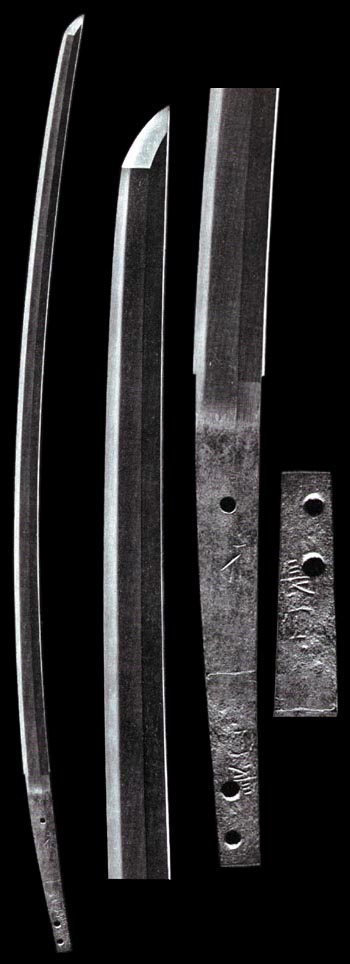| © Copyright Robert Cole 2015
- No copying or distributing The Eight DO SAIKAIDO - The Eight Roads of KOTO BUZEN USA * Swords and HACHIMAN "The God of War" * |
|
| Before young YAMATOTAKERU used the KUSANAGI
"Grass-cutting" Sword to evade the Trap of Fire set by
the EBISU (See
AME-MURAKUMO-no-TSURUGI), he had engaged his
precocious creativity against the ever threatening
KUMASO - the descendants of Borneo invaders on KYUSHU.
Using his youthful good-looks in the guise of a girl,
he seduced an introduction and killed their beguiled
leader.
YAMATOTAKERU's son, Emperor CHUAI still laboring the task of the KUMASO, spearheaded a drive through NAGATO into KYUSHU. |
| His wife, JINGO-KOGO and her
close minister, TAKESHIUCHI-no-SUKUNE
saw that the main supply and conspiring force under
their enemy was the SAN-KAN Three Kingdoms of faraway
Korea. The Gods, it seems, revealed to JINGO in a
dream that a solution was cutting the cancer at its
root by crossing the great sea to strike the Korean
heartland.
CHUAI was fearful and their strategy council became divided. In spite of the Gods and JINGO, he decided to continue his press on KYUSHU. Oddly, - CHUAI died. Although pregnant with the future Emperor, the formidable JINGO-KOGO put a rock in her sash to delay his birth and set about the conquest of Korea. |
 Jingo-kogo |
| On the voyage, the favorable Sea-god, SUMIYOSHI
piloted her foundering ships through a raging tempest
by evoking an army of huge fish, who joined their
cause and bore them forth.
She spent three years with TAKESHIUCHI on their SAN-KAN SEIBATSU receiving the submission of SHINRA, KORAI and the thereafter always faithful ally, HAKUSAI or KUDERA. She finally returned to KYUSHU for the long awaited birth of HONDA-WAKE-no-MIKOTO, who would become Emperor OJIN. Of course, the two sons of one of CHUAI's concubines tried to take the Throne, but TAKESHIUCHI punished them with death. |
 Jingo in later-life |
JINGO-KOGO ruled for 69 years
until her death at 100.
She built the temple SUMINOE to revere SUMIYOSHI, her helper in the storm. Later, OJINs' son, Emperor NINTOKU, "The Great Wren" moved SUMINOE from KYUSHU to SETTSU. |
| Emperor OJIN is known as the God, HACHIMAN, "God
of War." He is the guardian deity of the MINAMOTO. Japanese history
records to his reign the arrival of the Korean
scholars, AJIKI in 284 and WANI in 285, both tutors
for son, Prince WAKI-IRATSUKO and thus bringers of
Chinese literature and Confucianism for the
country. See the following for HACHIMANs' swordsmith and servant, SHINSOKU. BUZEN USA |
HACHIMAN-GU *
Before Emperor KAMMU's Chinese Dream - HEIAN-KYO *
A SHINTO priest of the HACHIMAN-GU Shrine in NARA. One of the most ancient names and root of the NARA sword school. It is said that the weapons and styles created by the early greats, AMAKUNI, AMAKURA and SHINSOKU were forged at the pleasure of the Imperial Court. When FUJIWARA MUCHIMARO built his JINGU-JI Temple, importing Buddhism to stand along side SHINTO in places of worship, SHINSOKU found it convenient to move his Shrine to BUZEN. Normally, one could not expect a Spirit to move to new Quarters. Fortunately, however, HACHIMAN, the God of War (swords quite pertinent), chose to bring SHINSOKU and his HACHIMAN-GU to KYUSHU, and also hit Empress GEMMEI to foot the tab. Accordingly, the BUZEN USA HACHIMAN DAI-JINGU Great Shrine rose in 712. SHINSOKU was the shining light, and a renegade not. - Who could find fault in following the dictates of God? - With his passing, of course, the widowed BUZEN USA fell from favor. Finally, fate for the faithful brought sword orders like rains on drought, - the aristocracy had sold their place - to the SAMURAI. ...And the name SHINSOKU is found on long swords once again. There are TANTO from the late KAMAKURA period and a noted SHINSOKU worked in YAMATO SENJUIN. TODAIJI Temple in NARA (spring-board of TEGAI) knew a SHINSOKU, as well. See the foregoing for HACHIMAN "The God of War" ______ KIYOKI WA-DO 708
|
_____ CHOEN EI-EN 987 to the KAMAKURA
| CHOEN
The sword of YOSHITOMO |
 |
CHOEN - A timeless name Those of the name CHOEN held the HEIAN spirit in their work. CHOEN appears in YAMATO, BUNGO and BUZEN on EI-EN swords, GEN-RYAKU and later. Mid-KAMAKURA was the main theater of production, however these smiths paid reverence without compromise for the late-HEIAN. SUGATA: Late-HEIAN style narrow TACHI with KO-KISSAKI said to resemble BUNGO SADAHIDE (JOSHU). Deep FUNBARI. KO-ITAME, evenly veiled in a JI-NIE of great beauty. Pieces show SUGU KO-MIDARE to KO-CHOJI KO-MIDARE with KO-NIE bathed in NIOI. _________ MASATSUNE TEN-PUKU 1233 (son of BITCHU MASATSUNE) MASATSUNE is a BIZEN name. His father, AOE NORITAKA's brother, brought the BIZEN style to a robust and prolific BITCHU. By TEN-PUKU, intense development melded BIZEN to BITCHU MORITSUGU KO-AOE styles. BITCHU MASATSUNE students, and sons, tended to the conservative. SUGU KO-MIDARE in knit KO-MOKUME. JI-NIE. Perhaps KO-CHOJI with ASHI. See KO-BIZEN and BITCHU KO-AOE. |
|